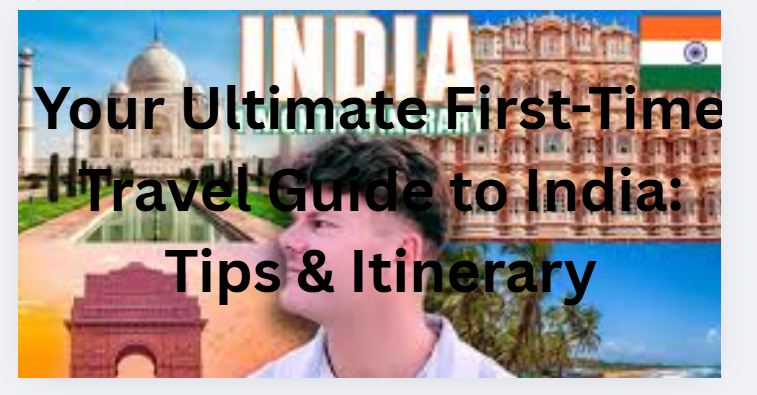
The thought of a first trip to India is thrilling. It’s a feeling of anticipation mixed with a healthy dose of uncertainty. You’ve heard stories of its vibrant colors, profound spirituality, and incredible food, but you’ve also heard about the crowds and the chaos. Let’s get one thing straight: India is not a destination you simply visit; it’s an experience you feel. It will challenge your senses, change your perspective, and leave you with stories for a lifetime.
This guide is designed to replace that uncertainty with excitement. We’ll walk through everything you need to know to plan an unforgettable and smooth first journey to this incredible country.
Getting Ready: Before You Go
A little preparation goes a long way in India. Sorting out the basics before you land will give you the confidence to embrace the adventure.
Visas and Documents
First things first, most foreign nationals need a visa. The good news is that getting an e-Visa for tourism is a straightforward online process. Apply through the official Indian government website at least a week before your trip. Also, ensure your passport is valid for at least six months beyond your date of entry. Keep digital copies of your passport, visa, and travel insurance in your email as a backup.
Your Health is a Priority
It’s wise to consult your doctor about recommended vaccinations a few weeks before travel. As for the famous “Delhi Belly,” the key is to be cautious. Stick to bottled or filtered water, and be mindful of what you eat. Enjoy the incredible street food, but choose vendors that are busy with locals, as a high turnover means fresher food. Avoid uncooked salads and peeled fruits from street stalls. Your stomach will thank you.
When to Visit: Timing is Everything
India has three main seasons, and when you go will shape your experience.
- Cool & Dry (October to March): This is the peak season for a reason. The weather across most of the country is pleasant, making it ideal for sightseeing. This is the best time for a first-time visitor.
- Hot & Dry (April to June): Temperatures can become intense, especially in the central and northern regions. It’s still manageable if you can handle the heat, but be prepared.
- Monsoon (July to September): Heavy rains sweep across the country. While the landscape turns a lush green, travel can be disrupted by flooding. It’s a beautiful but challenging time to visit.
Packing Your Bags: Less is More
Pack light, comfortable clothing made from natural fabrics like cotton. While India is modern, dressing modestly is a sign of respect, especially when visiting temples. For women, this means covering your shoulders and knees. A light scarf is incredibly versatile for this. For men, long pants are preferable to shorts at religious sites. Don’t forget comfortable walking shoes, a reusable water bottle, sunscreen, and any essential medications.
Finding Your Feet: Arrival and Navigating the Chaos

Your first moments in India can be overwhelming. The heat, the sounds, the crowds—it’s a sensory explosion. Take a deep breath and ease into it.
Getting Around
India’s transport network is vast and varied.
- Taxis and Ride-Sharing: Apps like Uber and Ola are lifesavers in major cities. They offer fixed fares, so you avoid haggling. For regular taxis and auto-rickshaws, always agree on a price before you get in.
- Trains: Traveling by train is a quintessential Indian experience. For long distances, book tickets in advance through the IRCTC website or a reliable travel agent. Opt for AC classes for a more comfortable journey.
- Domestic Flights: For covering large distances quickly (e.g., Delhi to Goa), domestic flights are affordable and efficient.
A Note on Safety
India is generally a safe country for travelers, but like anywhere, it’s important to be smart. Be aware of your surroundings, especially at night. As a solo female traveler, you may attract unwanted attention; dressing modestly and projecting confidence can help. Trust your instincts—if a situation feels wrong, remove yourself from it.
A Suggested Itinerary for Your First Trip: The Golden Triangle
For a first-time visit, the “Golden Triangle” route is perfect. It covers three iconic destinations in North India over 10-12 days, offering a fantastic blend of history, culture, and excitement.
Delhi: The Capital’s Contrast
Spend 2-3 days here. Delhi is a city of two halves. In Old Delhi, get lost in the narrow lanes of Chandni Chowk, witness the grandeur of the Jama Masjid, and explore the Red Fort. In New Delhi, see the impressive India Gate, the peaceful Lotus Temple, and the Qutub Minar, a towering minaret from the 12th century. The city’s metro system is clean and easy to use.
Agra: Home to an Icon
A short train ride from Delhi is Agra. The main event, of course, is the Taj Mahal. Go at sunrise to see the marble glow and avoid the biggest crowds. It’s even more breathtaking in person than in any photograph. Also, visit the massive Agra Fort for another perspective on Mughal history. One full day is enough for Agra.
Jaipur: The Pink City
From Agra, head to Jaipur, the vibrant capital of Rajasthan. Spend 3 days here. Explore the magnificent Amber Fort, perched on a hilltop. Wander through the City Palace, and marvel at the unique architecture of Hawa Mahal (the Palace of Winds). Jaipur is a shopper’s paradise for textiles, jewelry, and handicrafts. The energy here is infectious.
Embracing the Experience: Final Tips
To truly enjoy India, you have to go with the flow. Things won’t always go to plan, and that’s part of the adventure.
- Slow Down: Don’t try to see everything. It’s better to fully experience a few places than to rush through a dozen.
- Learn a Few Words: A simple “Namaste” (hello) or “Shukriya” (thank you) will bring smiles and open doors.
- Eat Smart, Eat Well: Don’t be afraid of the food—it’s one of the highlights! Just stick to the rules mentioned earlier.
- Be Patient: Things move at a different pace in India. Bureaucracy can be slow, and traffic is unpredictable. Take a deep breath and accept it.
Conclusion
India is a country that stays with you long after you’ve left. It’s a place of profound beauty, overwhelming generosity, and endless discovery. With this guide in hand, you’re ready to step into the chaos and discover the magic for yourself.
Frequently Asked Questions (FAQs)
Is India safe for solo female travelers?
India is generally safe for travelers, including women, but it requires a bit more awareness. Dressing modestly (covering shoulders and knees) helps you blend in and reduces unwanted attention. Avoid walking alone in isolated areas at night, and use trusted transportation like Uber or Ola. Trust your instincts—if a situation feels uncomfortable, remove yourself from it. Most travelers have a wonderful, incident-free experience by following these simple precautions.
How much money should I budget per day?
India can suit almost any budget. A comfortable mid-range traveler, staying in decent hotels, eating at good restaurants, and using taxis for sightseeing, can expect to spend between $40-$70 USD per day. Budget backpackers staying in hostels and using local transport can manage on $20-$30 USD. Luxury travel, of course, can cost significantly more.
What’s the best way to handle the food and avoid getting sick?
“Delhi Belly” is a common concern, but it’s often avoidable. The golden rule is to drink only bottled or filtered water. When it comes to food, eat where it’s busy—a high turnover means the food is fresh. Stick to hot, freshly cooked dishes and avoid uncooked salads, pre-cut fruit, and food that looks like it’s been sitting out. Don’t miss out on the amazing street food; just be smart about your choices. Many travelers also recommend probiotics before and during the trip.
Do I need to tip?
Tipping is appreciated but not always mandatory. In restaurants, a 10% tip is standard if a service charge isn’t already included in the bill. For hotel porters, 50-100 rupees per bag is customary. For taxi drivers, rounding up the fare is a nice gesture, especially if they’ve been helpful. It’s always a good idea to carry small notes for this purpose.
How should I dress for visiting temples?
Modesty is key. For both men and women, this means covering your shoulders and knees. You’ll often be required to remove your shoes before entering a temple or mosque. Carrying a light scarf or shawl in your day bag is a perfect solution for quickly covering up when needed. Some sacred sites, like Sikh Gurudwaras, will also require you to cover your head.
Is the language barrier a big problem?
In major cities and tourist areas, you’ll find that many people involved in the tourism industry speak English. However, learning a few basic Hindi phrases will greatly enhance your experience and is seen as a sign of respect. Simple words like “Namaste” (Hello), “Shukriya” (Thank you), and “Kitna hua?” (How much is it?) can go a long way.